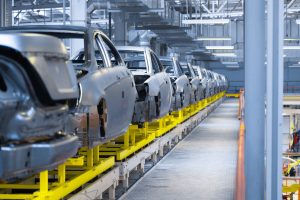Manufacturing is one of the most international industries, with processes and operations often spanning across different countries. From sourcing raw materials to final assembly, manufacturing companies rely on a global network of suppliers, partners, and customers. However, this global reach comes with its own set of challenges, particularly language barriers that can impede effective communication. In fact, a report found that 22% of manufacturing companies report that they couldn’t pursue or lost business due to language barriers.
As a result, manufacturing translation has become a key component of a successful global strategy in this industry. Let’s take a look at what manufacturing translation is, its benefits, and the best practices you can use to improve your global communications and operations.
What Is Manufacturing Translation
Manufacturing translation is the process of transferring technical, R&D, scientific, legal, medical, and marketing information from one language to another at any stage of the manufacturing process. This service is essential for industries such as technology, machinery, consumer electronics, transportation, food and beverage, and many more.
Manufacturing translation covers a wide range of documents and materials, from technical specifications to regulatory filings. Here are some of the most common types:
- User manuals
- Operating instructions
- Standard Operating Procedures (SOPs)
- Product descriptions and packaging
- CAD drawings
- Software and websites
- CAD drawings
- Legal documents
- Training materials
- Patents
- Regulatory and compliance documentation
- Technical and engineering documents
Why Manufacturing Translation Is Important
Technical translation is key to the international success of modern manufacturing enterprises. It ensures that complex technical information, crucial for the design, production, and distribution of products, is accurately communicated across global operations. Manufacturing translation helps:
Ensure Consistency and Accuracy
Clear, consistent documentation helps all stakeholders—engineers, technicians, regulators, and customers—understand product specifications, quality standards, and procedures. Accurate translations minimize errors and ensure uniform performance across locations.
Facilitate Regulatory Compliance
The manufacturing industry is subject to strict regulations in every market. Whether it’s EU directives, FDA requirements, or ISO certifications, accurate translation of compliance documents helps avoid legal issues and ensures product approval.
Enhance Productivity and Efficiency
Translated training guides, SOPs, and safety instructions allow multinational teams to work efficiently. When everyone understands the procedures in their own language, productivity increases and workplace accidents decrease.
Support Global Market Expansion
To succeed in new markets, manufacturers must translate customer-facing content such as product descriptions, technical support materials, and marketing collateral. This improves customer engagement, drives sales, and enhances your global brand reputation.
Improve Customer Experience
Providing user-friendly documentation in the customer’s language helps them use your products correctly and confidently. This reduces support requests, increases satisfaction, and builds long-term loyalty.
8 Best Practices for Manufacturing Translation
1. Create High-Quality Source Texts
Creating clear and concise source text is the foundation of an effective manufacturing translation process. Ensure all technical terms, instructions, and specifications are accurate and unambiguous. Use standardized terminology and avoid idiomatic expressions that might not translate well into other languages. Detailed and well-structured source texts minimize the risk of errors and misunderstandings during translation. This is especially important in manufacturing, where inaccuracies can lead to costly production errors or safety issues. High-quality source content speeds up the translation process, allowing translators to focus on accuracy rather than clarifying ambiguities.
2. Maintain Consistency in Multilingual Content
Consistency is key in manufacturing translation, where accurate terminology and instructions are critical. Implement style guides and glossaries for each target language to ensure consistency. These tools help maintain the integrity of the information, ensuring that terms and phrases are translated the same way every time. Consistent terminology improves the clarity of the translated content, making it easier for users to understand and follow instructions. Translation memories can also be used to keep track of previously translated content, ensuring consistency and reducing the workload for translators.
3. Localize Content for Better Customer Experience
In manufacturing translation, simply converting words from one language to another isn’t enough. To truly communicate technical information effectively, you need to localize your content to suit the cultural and geographic nuances of your target markets. This means adjusting measurement units, date formats, currencies, and even colors or images to align with local standards and expectations. Proper localization ensures that your manufacturing documents, manuals, and instructions are not only accurate but also clear and relevant to users in each region.
4. Use Machine Translation When Appropriate
Machine translation can be a valuable tool for handling large volumes of repetitive, technical manufacturing content where speed is a priority. For instance, product specifications or large documentation sets can be quickly translated using machine translation. However, it’s important to combine machine translation with human post-editing to ensure accuracy and readability. Human translators can correct errors, refine language, and ensure that the translated text conveys the intended meaning accurately. This hybrid approach can save time and reduce costs without sacrificing quality, making it a practical solution for many manufacturing translation needs.
5. Work with Subject Matter Experts
Not all translators are equipped to handle the complexity of manufacturing content. Choose professionals who have technical backgrounds or proven experience in your specific industry—whether that’s automotive, aerospace, electronics, or machinery. Subject matter experts understand the terminology, the real-world applications, and the regulatory environment. They can translate technical concepts accurately and spot errors that generalist translators might miss. This reduces costly revisions and supports safety and compliance from the start.
6. Plan for Design and Layout Adjustments
Text expansion and contraction are common issues in translation. For example, German text can be 30% longer than English, while Chinese usually takes up less space. If your documents or user interfaces are tightly designed, you may run into layout problems when translated. To avoid this, leave extra space around text elements in your designs. Avoid embedding words in images when possible, and design flexible templates that accommodate different language lengths. Planning ahead helps you avoid costly design rework later.
7. Test Translated Content in Context
A translation may look accurate on paper, but problems often appear during implementation. Before going live, always test the content in its final format—whether it’s a printed label, a website interface, or a machine display screen. This helps you identify layout issues, truncated words, mismatched fonts, or incorrectly placed symbols. Ideally, conduct these reviews with in-country teams or native speakers who understand both the language and the user expectations in their market.
8. Keep Regulatory Updates in Mind
Manufacturing documentation is often subject to industry regulations and government standards. These regulations change over time—sometimes frequently—and can vary significantly by region. Safety manuals, compliance labels, and certification documents must be updated regularly to remain valid. Your translation process should include a system for monitoring legal updates and triggering timely revisions across all language versions. Outdated translations not only lead to compliance failures but can also result in costly penalties or product recalls.
Partner with EC Innovations for Manufacturing Translation
EC Innovations offers comprehensive manufacturing translation services in over 140 languages. With our team of professional resources and advanced technological capabilities, we ensure a streamlined translation process. We help you save costs, reduce time-to-market, and maintain high-quality content across your global operations. Contact us today to learn more!

